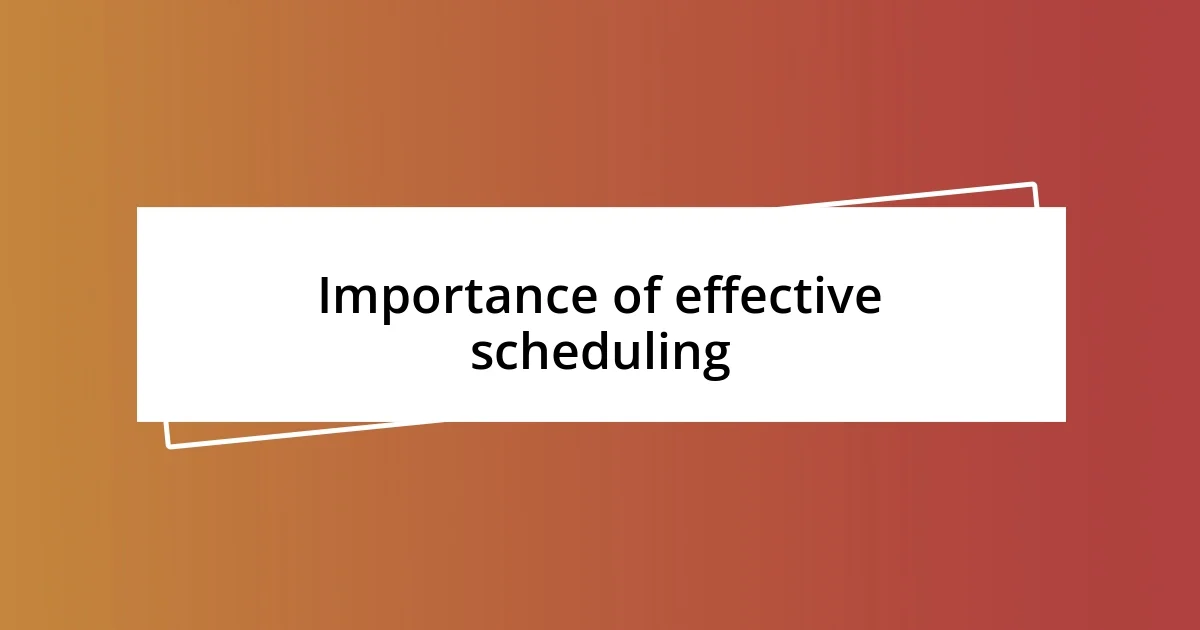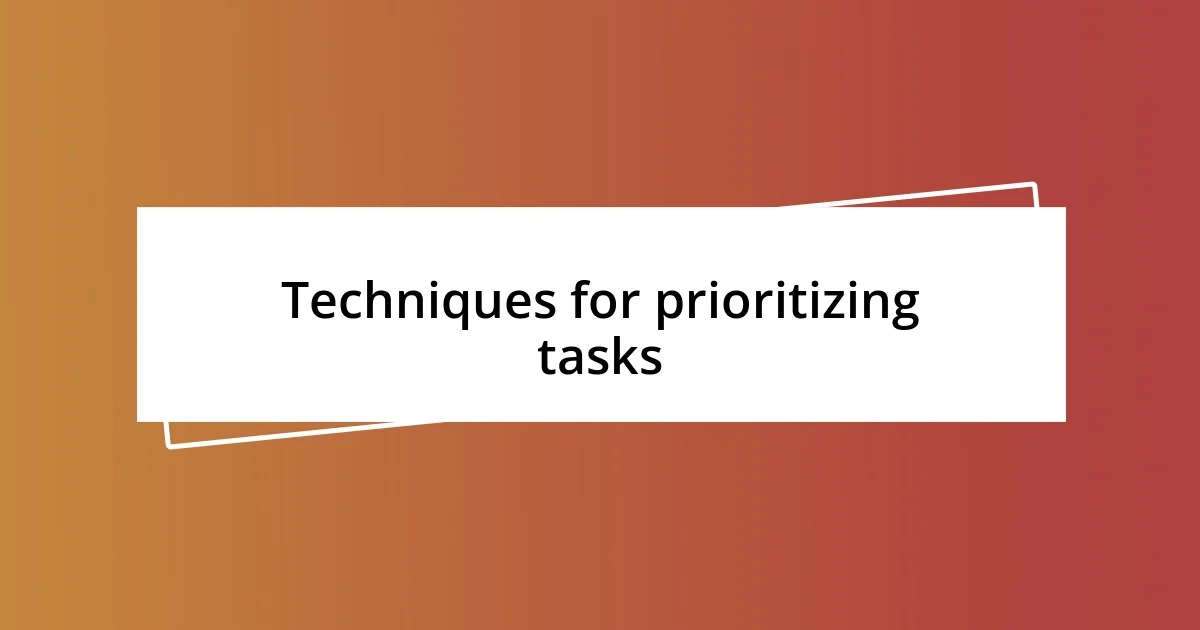Key takeaways:
- Burnout is caused by factors like excessive workloads, lack of control, and negative workplace culture; effective scheduling is crucial for maintaining well-being.
- Techniques such as the Eisenhower Matrix and the ABC prioritization method help prioritize tasks, while incorporating breaks boosts productivity and reduces overwhelm.
- Using digital tools like Google Calendar and Trello enhances task management, while regularly evaluating and adjusting one’s schedule improves adaptability and stress management.

Understanding burnout and its causes
Burnout is a state of physical, emotional, and mental exhaustion caused by prolonged stress, often linked to work or caregiving responsibilities. I remember the first time I felt it creeping in—my enthusiasm for projects waned, and even small tasks felt insurmountable. Can you relate to those moments when everything feels like too much, and you just want to hit pause on life?
Several factors contribute to burnout, including excessive workloads, lack of control, and insufficient support. Reflecting on my early career, I often took on too many responsibilities, believing I was invincible. It wasn’t until my creativity dimmed and my sleep became disrupted that I realized how crucial a balanced schedule is for maintaining my well-being.
Additionally, workplace culture plays a significant role in burnout. I can think back to a team environment where competition overshadowed collaboration; it left many of us feeling isolated. Have you ever experienced a similar culture where climbing the ladder seemed more important than supporting each other? Such an environment can drain your energy and passion, making it essential to recognize and address these damaging dynamics.

Importance of effective scheduling
Effective scheduling is more than just organizing tasks; it’s a lifeline against burnout. I vividly remember a time when I didn’t prioritize my schedule. My days bled into one another, and I often worked late into the night, feeling perpetually overwhelmed. By setting clear timelines and boundaries, I learned to control my workload, giving myself the breathing room I desperately needed.
Here’s why effective scheduling matters:
- Enhances Productivity: I noticed that by allocating specific times for focused work, I was able to complete tasks more efficiently, freeing up time for breaks.
- Reduces Stress: A structured schedule minimizes anxiety. Knowing what’s coming next provides a sense of control.
- Encourages Work-Life Balance: I’ve found that scheduling personal time is just as critical as work commitments. It nurtures my passions and relationships.
- Prevents Overcommitment: I used to fill my calendar to the brim, but now, I’m more selective. This means I can say yes to the things that truly matter without burning out.
- Promotes Self-Care: Including downtime in your schedule is essential. I schedule time for exercise and relaxation, which rejuvenates my spirit.
As life unfolds, I’ve learned to treat my scheduling as a dynamic tool, adjusting as necessary to maintain that delicate balance between my aspirations and well-being.

Techniques for prioritizing tasks
The first technique I use for prioritizing tasks is the Eisenhower Matrix, which categorizes tasks into four quadrants based on urgency and importance. This method has been a game changer for me. When I first started using it, I realized how much time I was wasting on tasks that were neither urgent nor important. By visualizing my priorities, I learned to focus on what truly matters—not just what was screaming for my attention.
Another great technique is the ‘ABC’ prioritization method, where I assign A for urgent and important tasks, B for important but not urgent, and C for non-urgent and non-important tasks. This has helped me avoid the trap of confusion and ensures I tackle my most impactful tasks first. For instance, I once mistakenly spent hours on a C task, thinking it was crucial, only to recognize I was skirting around my A tasks, which ultimately mattered more to my success.
I also find it valuable to practice the ‘two-minute rule’. If a task can be completed in two minutes or less, I tackle it immediately. This simple technique has significantly reduced my feelings of overwhelm. Initially, I was hesitant, thinking I shouldn’t interrupt my workflow. However, I soon discovered that knocking out these quick tasks not only cleared my to-do list faster but also gave me a little boost of accomplishment that kept my motivation high.
| Technique | Description |
|---|---|
| Eisenhower Matrix | Prioritizes tasks by urgency and importance, helping focus on what truly matters. |
| ABC Prioritization | Assigns tasks based on their importance and urgency to tackle impactful tasks first. |
| Two-Minute Rule | Encourages immediate action on tasks that take two minutes or less, reducing overwhelm. |

Incorporating breaks into your routine
Incorporating breaks into my routine has been a game changer for my productivity and overall well-being. I remember pushing through long hours without a pause, thinking that every minute spent working was vital. However, I soon learned that taking short breaks not only refreshed my mind but also reignited my focus. Now, I use the Pomodoro Technique, working for 25 minutes and then treating myself to a 5-minute break. It’s incredible how just stepping away from my screen can provide a burst of clarity.
I often ask myself, “What’s the point of working hard if I’m too exhausted to enjoy the results?” This question shaped my approach to breaks. I’ve started scheduling longer breaks in the middle of my day, often dedicating at least half an hour to activities that recharge me, like walking, meditating, or even just enjoying a warm cup of tea. This respite has become my secret weapon; it allows me to return to my tasks with renewed energy and creativity, transforming the way I tackle my work.
On days when I feel particularly drained, I find it beneficial to incorporate micro-breaks—just a minute to stretch or breathe deeply. Surprisingly, these small moments add up. I never used to prioritize these, thinking they’d be a waste of time. Yet, they have become essential. By acknowledging that my mind isn’t a machine, but rather a resource that requires nurturing, I’ve dramatically improved my mental clarity and resilience against burnout. How have breaks helped you in your routine?

Tools for managing your schedule
When it comes to managing my schedule, I’ve found that digital tools are indispensable. Applications like Google Calendar allow me to visualize my commitments and set reminders that keep me on track. I remember a time when I relied solely on to-do lists scribbled on paper; I often missed deadlines because I’d overlook tasks. Now, I proudly rely on my calendar, and I can’t tell you how much more organized—and calm—I feel.
I also appreciate task management apps like Trello and Todoist. They provide flexible ways to break down projects into manageable steps. The drag-and-drop feature in Trello, for instance, lets me categorize tasks easily and visualize progress. I’ve had days where I felt completely overwhelmed with my workload, but by simply organizing tasks into these apps, I was able to categorize and conquer my to-do list more easily. There’s something gratifying about moving a task from “In Progress” to “Completed,” don’t you think?
For those of us who thrive on a tactile experience, I can’t recommend a good old-fashioned planner enough. There’s a unique satisfaction in physically writing things down. I often find myself doodling or adding personal notes in the margins. This practice not only helps me remember important deadlines but also allows for a creative outlet in my otherwise digital-heavy life. Have you ever tried that? It’s a great way to blend creativity and structure, and it might just be the balance you need to keep burnout at bay.

Evaluating and adjusting your approach
Evaluating your approach to scheduling is essential for maintaining your well-being. I remember a time when I thought my schedule was perfectly optimized, only to feel overwhelmed and constantly stressed. It’s eye-opening to examine what’s working and what isn’t. Regularly reassessing my commitments allows me to make informed decisions about priorities. Are there tasks that drain my energy? I’ve discovered that leaning into my strengths and letting go of areas that don’t serve me well has been incredibly freeing.
Adjusting my schedule isn’t merely about cutting back; it’s also about recalibration. I often find myself reflecting on my energy levels at the end of each week. Are there certain days when I’m more productive? Maybe a project took longer than expected. By acknowledging these patterns, I’ve learned to reserve my more demanding tasks for my peak energy times. How do you identify your productive moments? For me, it’s the difference between feeling like a hamster on a wheel and actually feeling accomplished at the end of the day.
I’ve also realized that flexibility is key. Life is unpredictable, and sometimes my plans need a shake-up. Recently, a sudden family obligation forced me to rearrange my entire week. Instead of panicking, I adjusted my calendar and even found new pockets of time to squeeze in crucial projects. This experience taught me that having a flexible approach makes it easier to handle surprises without tipping into burnout. In what ways do you remain adaptable in your own scheduling? Embracing flexibility not only diminishes stress but also opens the door to unexpected opportunities.













